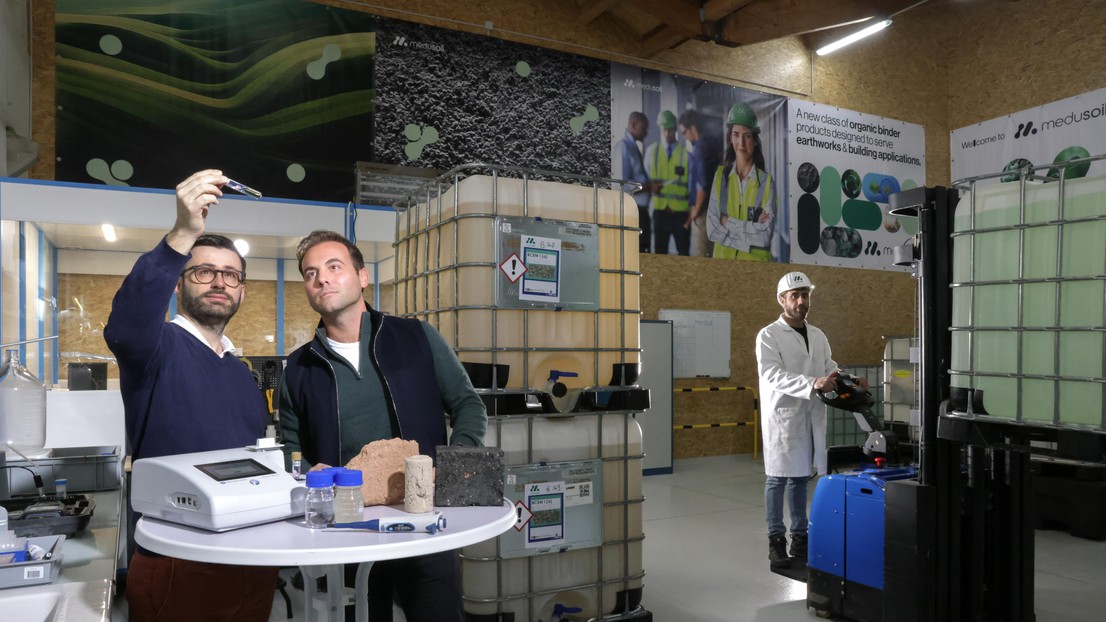
Three members of the Medusoil team - Vincent Laurençon, Dimitrios Terzis and Roberto Perez - at their production plant in Vaud canton. © Alain Herzog / EPFL 2025 - CC-BY-SA 4.0
A recent study examines the effectiveness of environmental strains for the production of biocement. The study's lead author, Dimitrios Terzis, is an EPFL senior scientist and a co-founder of Medusoil, a company that produces organic binders and that opened a production plant in Vaud in 2024.
"For me, it's essential to keep conducting fundamental research," says Terzis, a civil engineer at EPFL's Soil Mechanics Laboratory. His company Medusoil produces organic binders that are similar to biocement. For the study he published recently in Scientific Reports, Terzis worked with scientists from the University of Applied Sciences and Arts of Southern Switzerland to analyze 50 bacteria strains sourced from farmland in Ticino canton. This land is used for grazing dairy cattle and has shown to be particularly well suited for the production of Medusoil's biocement due to the widely available presence of calcium. Biocementation relies on stimulating a natural process: the secretion by microorganisms of an enzyme that triggers the formation of carbonate, which then binds with the calcium largely present in the soil to form calcite, a natural cement.
The study identified which naturally occurring strains fabricate the enzyme required for carbonate formation and can be fermented - two factors that make them prime candidates for biocement production. The scientists created a culture of the most promising strain, which was inoculated in a 1.5-meter-high column of sand. After 24 hours of infiltration, the column was strong enough to sustain its weight and to be used in a variety of geotechnical engineering and geoenvironmental applications, like erosion. The scientists also found that using this strain could cut production costs by 40%.

A paradigm shift
Medusoil, founded seven years ago, supplies organic binders whose carbon impact is at least 55% lower than that of standard cement, which is made by heating an 80% limestone/20% clay mixture to high temperatures. Biocement can be used in a number of geotechnical and building applications, such as to reinforce dams, prevent soil erosion by wind and help protect areas subject to landslides, earthquakes or cyclic loads induced by road and railway traffic. To test yet another application, the company's biocement was used in a project in Geneva to recover concrete aggregates from demolished buildings. And because biocement can be employed several times, it supports the circular economy. In the Scientific Reports study, the authors note that this naturally occurring biocementation process can be applied at a large scale and can help drive a paradigm shift towards greater sustainability in the construction industry.
New production plant
Medusoil reached a new milestone in 2024 with the opening of a production plant in Molondin, near Yverdon-les-Bains. "The plant can generate 400,000 liters of biocement per year, which is enough to stabilize five kilometers of riverbank against erosion," says Vincent Laurençon, Medusoil's head of manufacturing. The company also has a mobile biocementation plant designed to make use of local raw materials. It was recently transported by truck to Romania, for example, where it was employed to reinforce roads. The firm intends to pursue its cutting-edge R&D and has projects lined up this year in France, the Middle East and the Netherlands.







